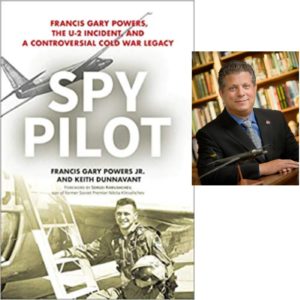Podcast: Play in new window | Download
Subscribe: RSS

Francis Gary Powers, Jr. is son of the famed U-2 pilot who was downed during a mission. Gary has spent years researching his father’s life and developing the Cold War Museum. We spoke about his new book that covers his father’s and family’s life and career.
1:06 – Gary explained why he wrote the book on his father.
4:00 – Gary talks about he structured the book. He discusses who he interviewed for the book and FOIA requests.
5:53 – Gary talked about how he got the government to help him with his research.
10:18 – Gary talks about how the US government initially refused to believe that the Soviets had missiles that could have reached his father’s plane.
12:00 – Gary talks about how he got into this research.
15:50 – Gary talks about the various sections of the book.
17:01 – Gary talks about how his book adds to the history of this event.
18:40 – Gary talks about the Soviet pilot who was shot down chasing Gary Powers.
21:25 – Gary talks about how the Russians celebrated their pilots.
25:20 – Gary talks about his involvement with the movie “Bridge of Spies.”
28:56 – Gary talks about the Cold War Museum.
34:51 – Gary talks about some of the interesting spy and other items held at the Cold War Museum.
41:51 – Gary talks about the similarities between early NASA and the military.
44:00 – Gary talks about old audio recordings his father had made [that] years ago.
46:42 – Gary talks about the extensive physical and mental testing U-2 pilots went through.
53:58 – Gary has sites at coldwar.org for the museum. Gary has garypowers.com or spypilotbook.com.
Links of interest
For more “Military History Inside Out” please follow me on Facebook at warscholar, on twitter at Warscholar, on youtube at warscholar1945 and on Instagram @crisalvarezswarscholar
Guests: Francis Gary Powers, Jr.
Host: Cris Alvarez
Tags: military, history, military history, conflict, war, interview, non-fiction book, U-2, spy missions, cold war museum, Gary Powers, veterans, CIA, Air Force, medals, missiles, eisenhower, krushchev, latvian rugs, vladimir prison, bridge of spies, afghanistan
